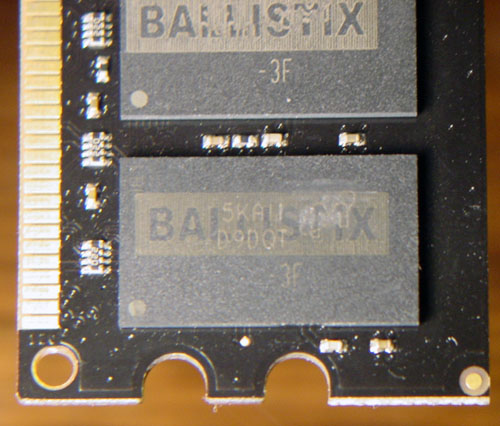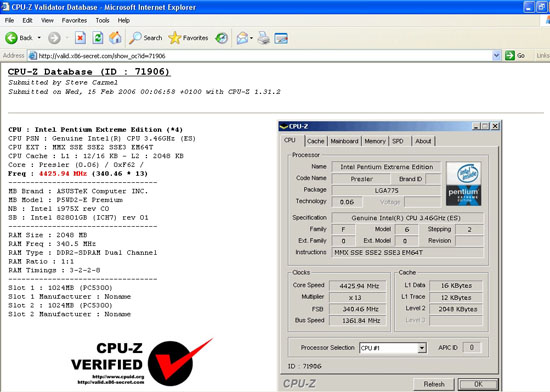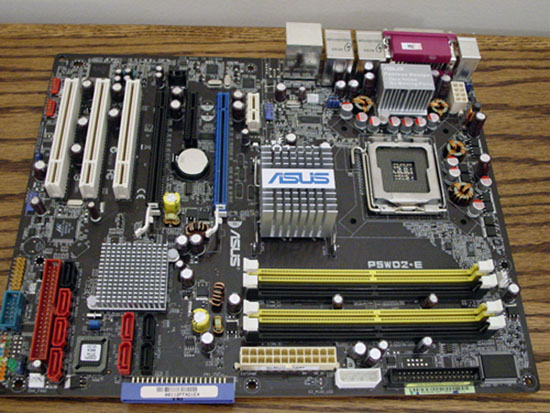Crucial Ballistix DDR2: The New DDR2 Standard?
by Steve Carmel & Wesley Fink on February 21, 2006 12:05 AM EST- Posted in
- Memory
The DDR2 market enjoyed some incredible DDR2 performance early in its life with a Micron DDR2 chip that we have since come to know as Fat Body D9. Everyone who made DDR2 used these chips because the performance was so outstanding, and when Micron decided to discontinue them last year, memory makers began scrambling for a replacement. Thus far, they haven't found a new DDR2 chip with the same low latency and high frequency capabilities of the now legendary Micron chips.
Two months ago, a new buzz began that Micron and their Crucial direct sales arm would be introducing a new and even better DDR2 memory chip. Every enthusiast memory maker with whom we talked about DDR2 was saying to wait until March when we have new high performance chips. Those chips, of course, are to be based on these new Micron DDR2 memory chips. When Crucial offered to send us their newest and top-performing DDR2 memory in early February, we couldn't wait to take a closer look. Were these the new Micron wonder DDR2?
In this review of two of the new Crucial Ballistix DDR2 kits, the biggest question on everyone's mind is: how will it compare to the legendary Fat Body D9 chips? Does it maintain tight timings at higher clock speeds? Is it still responsive to increased voltage like prior iterations of the Fat Body D9 made by Micron?
Crucial Technology's PC2-6400 has memory timings specified at 4-4-4-12 at speeds of DDR2-800. The other memory kit that Crucial sent along for testing was their PC2-5300, rated at DDR2-667 speeds with lower latency timings of 3-3-3-12.
What lies under the copper-colored, aluminum heat spreaders? Crucial Technology continues to use their trademark black PCB.
This depicts the PCB lurking underneath the Crucial Technology PC2-5300 DDR2 memory kit that we tested recently.
Closer examination of the IC's showed some distinctive markings, which can be used to help identify the integrated circuits that were used in construction of this particular memory module.
The 2nd row shows markings of D9DQT. Please note that the D9 is indicative of Micron's Fat Body integrated circuit. At the very bottom of the IC, there is a -3F marking, which is usually used for speed grading.
By entering the FBGA code into Micron's Part Marking Decoder, the search output was rather inconclusive. This part appears not to be in the Micron database yet. The restamping and lack of information from Micron keeps us wondering about the real speed of the new DDR2 Chips. Does this new die revision of the D9 IC's still contain 3.7ns chips as we saw with past D9?
With limited specifications and no memory ID that tells us anything, memory benchmarking is the only way to find out if the new memory from Crucial Technology can produce the widely anticipated results?
With the advent of the new 975X chipsets available on the market, this was a prime opportunity to test some new DDR2 modules from Crucial on this Intel based platform. AnandTech utilized the quite stable ASUS P5WD2-Premium motherboard, in conjunction with an Intel Pentium 955 Extreme Edition CPU, which sported a 1066MHz FSB dual core solution, containing a whopping 2MB of L2 cache onboard, as part of our testing platform. You can read our full Asus P5WD2-E Premium review here.
Asus advertises this particular motherboard in their February 2006 product information spreadsheet, claiming it as their flagship 975X motherboard with native DDR2 800 support. The chart below shows the myriad of memory options at different front side bus speeds available with this particular mainboard. The asterisks indicate settings provided for overclocking purposes only.
Two months ago, a new buzz began that Micron and their Crucial direct sales arm would be introducing a new and even better DDR2 memory chip. Every enthusiast memory maker with whom we talked about DDR2 was saying to wait until March when we have new high performance chips. Those chips, of course, are to be based on these new Micron DDR2 memory chips. When Crucial offered to send us their newest and top-performing DDR2 memory in early February, we couldn't wait to take a closer look. Were these the new Micron wonder DDR2?
In this review of two of the new Crucial Ballistix DDR2 kits, the biggest question on everyone's mind is: how will it compare to the legendary Fat Body D9 chips? Does it maintain tight timings at higher clock speeds? Is it still responsive to increased voltage like prior iterations of the Fat Body D9 made by Micron?
Crucial Technology's PC2-6400 has memory timings specified at 4-4-4-12 at speeds of DDR2-800. The other memory kit that Crucial sent along for testing was their PC2-5300, rated at DDR2-667 speeds with lower latency timings of 3-3-3-12.
What lies under the copper-colored, aluminum heat spreaders? Crucial Technology continues to use their trademark black PCB.

This depicts the PCB lurking underneath the Crucial Technology PC2-5300 DDR2 memory kit that we tested recently.
Closer examination of the IC's showed some distinctive markings, which can be used to help identify the integrated circuits that were used in construction of this particular memory module.

The 2nd row shows markings of D9DQT. Please note that the D9 is indicative of Micron's Fat Body integrated circuit. At the very bottom of the IC, there is a -3F marking, which is usually used for speed grading.
By entering the FBGA code into Micron's Part Marking Decoder, the search output was rather inconclusive. This part appears not to be in the Micron database yet. The restamping and lack of information from Micron keeps us wondering about the real speed of the new DDR2 Chips. Does this new die revision of the D9 IC's still contain 3.7ns chips as we saw with past D9?
With limited specifications and no memory ID that tells us anything, memory benchmarking is the only way to find out if the new memory from Crucial Technology can produce the widely anticipated results?
With the advent of the new 975X chipsets available on the market, this was a prime opportunity to test some new DDR2 modules from Crucial on this Intel based platform. AnandTech utilized the quite stable ASUS P5WD2-Premium motherboard, in conjunction with an Intel Pentium 955 Extreme Edition CPU, which sported a 1066MHz FSB dual core solution, containing a whopping 2MB of L2 cache onboard, as part of our testing platform. You can read our full Asus P5WD2-E Premium review here.
Asus advertises this particular motherboard in their February 2006 product information spreadsheet, claiming it as their flagship 975X motherboard with native DDR2 800 support. The chart below shows the myriad of memory options at different front side bus speeds available with this particular mainboard. The asterisks indicate settings provided for overclocking purposes only.
| FSB | Memory Configuration Options/ASUS P5WD2-E Premium Motherboard | |||||||
| Auto | DDR2-400 | DDR2-533 | DDR2-667 | DDR2-711* | DDR2-800* | DDR2-889* | DDR2-1067* | |
| FSB 1066 | * | * | * | * | * | * | * | * |
| FSB 800 | * | * | * | * | - | * | - | - |
| FSB 533 | * | * | * | - | - | - | - | - |













27 Comments
View All Comments
gudodayn - Tuesday, February 21, 2006 - link
Not to take anything away from Crucial or OCZ but DDR2~800 @ 4-4-4-12 has been on the market since last year!!!Like the article said "Other competing manufacturers such as Corsair and OCZ Technology will be able to source the same IC's......". This isnt just Corsair and OCZ, there are others. Mind you these US memory companies get their work done a lot by Taiwan manufacturers. How about Geil and PQI?? PQI have TurboMemory DDR2~900 @ 4-4-4-12 and a DDR2-1000 @ 5-5-5-15 and both are 1Gb sticks.
What makes these Crucial sticks special?? Nothing apparently according to the benchmarks. It is nothing more than a publicity advertisement for them......New DDR2 Standard?? I think not!!!!
Unless you have a rare batch of TCCD equivalent in DDR2 form, the playing field seems pretty even between memory manufacturers to me at the moment.
Xenoterranos - Tuesday, February 21, 2006 - link
Ah winbond megachips, where have you gone to??ozzimark - Tuesday, February 21, 2006 - link
slightly confused because i don't think i ever see the pc2-6400 running at 400mhz? just give me a chart with the max speed with varying timings and i'll be happy. if not, i'll get some myself and do it :pAvalon - Tuesday, February 21, 2006 - link
No, I'm with you Zebo. I can't wait for DDR2 on AMD's AM2. I'll be getting one of those 35w X2 3800+ CPUs and some phase change ;)BrownTown - Tuesday, February 21, 2006 - link
why the heck would anyone get phase change on a 35W CPU, thats complete freaking overkill. I hope its not because you intend to overclock it becasue then you will be sorely disapointed. How do you think AMD got it down to 35W? they replaced the current highspeed transistors with ones that sacrifice speed for power consumption. OF course with the FX-62 they have to go the other way and therefore get 125W, but great speed. Seeing as that only a 50% clock increase for more then 3x the power consumption. The new low power transistors will be low-voltage, low-power, and low-speed. Sorry, no free lunch, everything comes at a cost, and here its power for speed.Leonidas1 - Tuesday, February 21, 2006 - link
Haha, lower speed transistors, you think they would honestly engineer two versons? I highly doubt it, I don't know a lot about CPU's but my guess is that these low power chips are got the same way the turions are they are tested and binned for speed and voltage. The ones that work at lower voltages at high speeds become these special low wattage CPUs and the others become regulars. I dont know about overclocking but I would guess they would overclock better too. Just a guess because no one knows yet though.BrownTown - Wednesday, February 22, 2006 - link
its always interesting when people mock you and then follow it by saying "I don't know a lot about CPU's". But, you are right, they will do the same that they did with Turion. And what they did with Turion was to use differnet transistors than they did in the A64... Before making statements its best to confirm with Google, takes 10 seconds and make you not look like an idiot...ozzimark - Tuesday, February 21, 2006 - link
there are "fast" and "slow" transistors actually.. ;)Zebo - Tuesday, February 21, 2006 - link
Am I the only pne who can't wait for DDR2 to be supported by AMD on 6/6/6? Rumour has it unofficial DDR2-800 support - combined with A64 superior memcontroller 3-2-2 800 possible? I hope it's tested Wes.Googer - Wednesday, February 22, 2006 - link
Zebo, I think I am staying away form any RAM that has Satanic Memory Timings.As for the Socket AM2 Tomshardware has already benchmarked it.
http://www.tomshardware.com/2006/02/21/a_look_at_a...">http://www.tomshardware.com/2006/02/21/a_look_at_a...